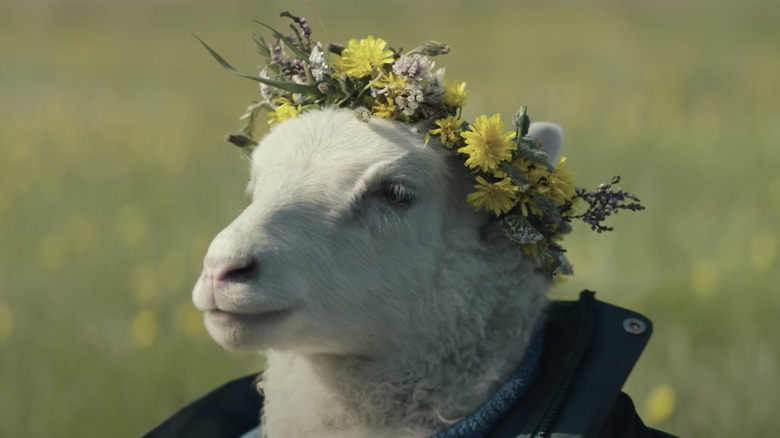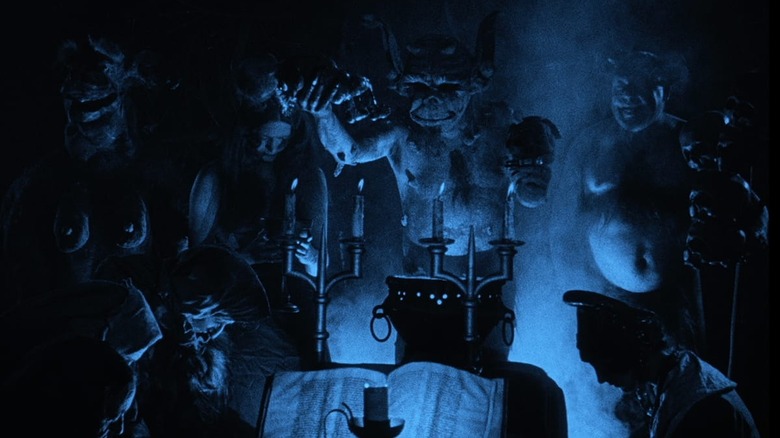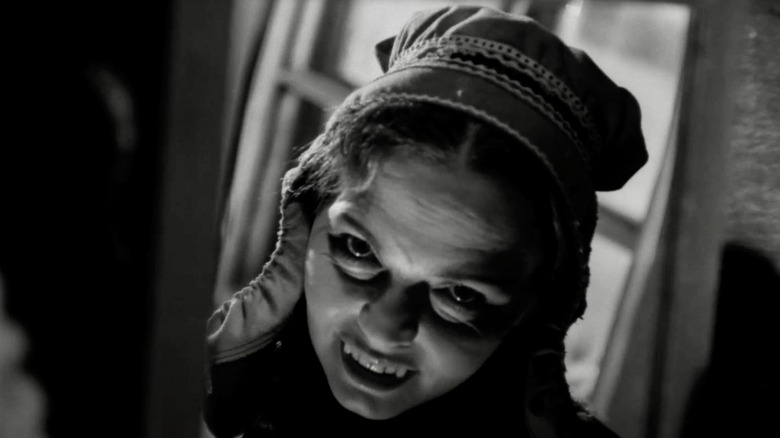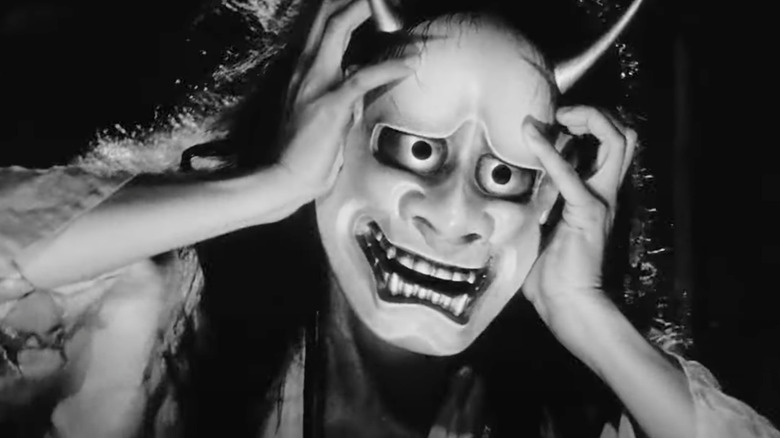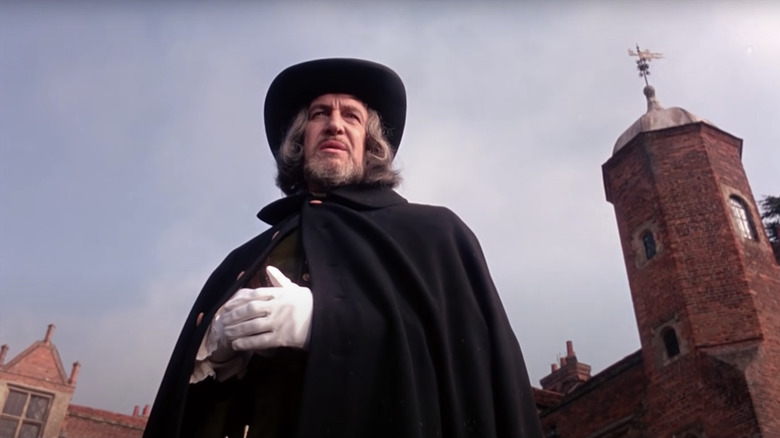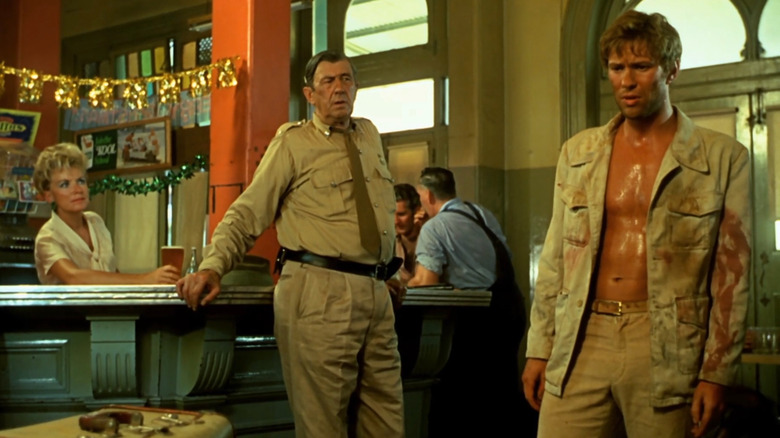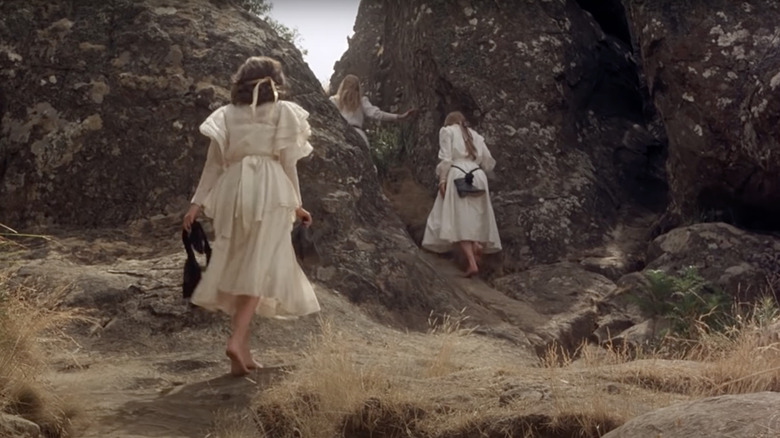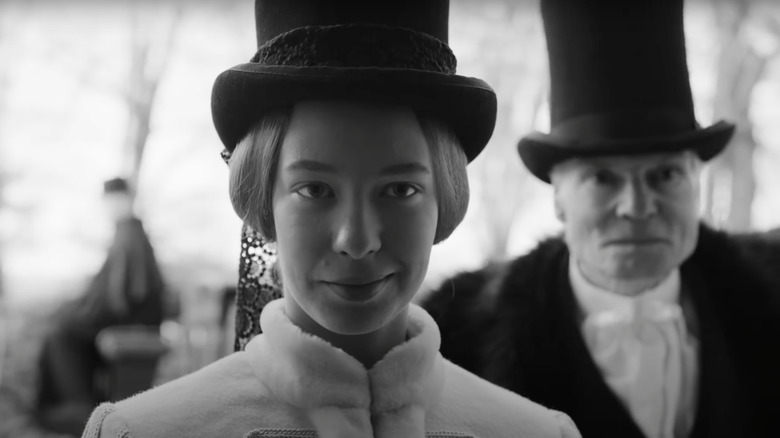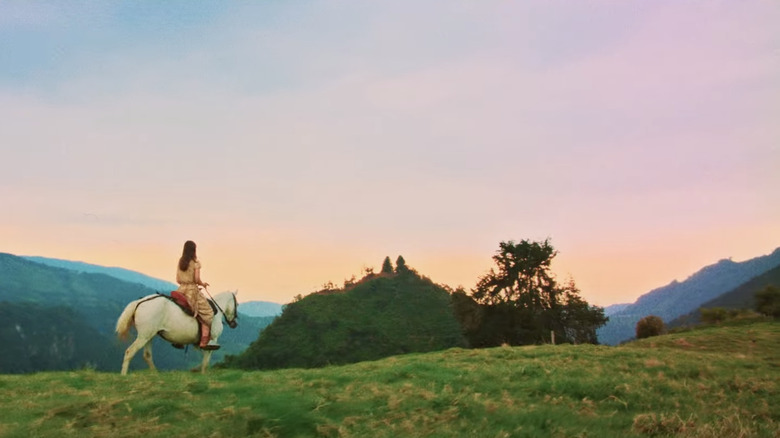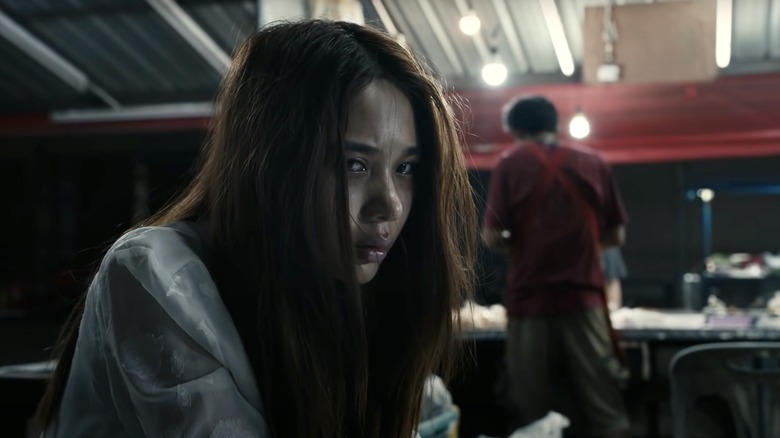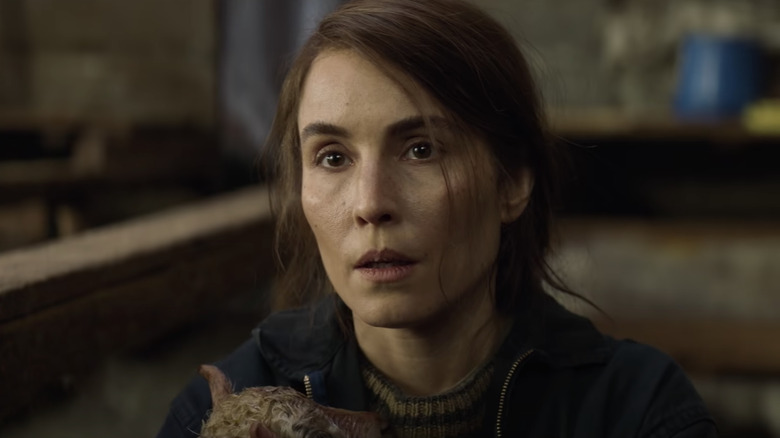Folk Horror World Tour: 10 International Titles From The Last 100 Years
Folk horror is more than just pagan cults in the British Isles immolating Christians, or Christian cults in the American Midwest crucifying people on corn crosses. The genre is all about the old ways resurfacing. As the summer solstice approaches, and as films like "Men" and "You Won't Be Alone" keep folk horror alive, it seems appropriate, then, to unearth some older recommendations, dating all the way back to 1922, just as we've been doing with our "Year of the Vampire" series.
In recent years, we've examined the original "Wicker Man" and films like it from the 2010s folk horror revival, when "Midsommar" and other movies delivered new adventures in human sacrifice. We've also done a general folk horror ranking, and there's enough overlap between the two lists that you can tell who the usual suspects are by now. With this list, we'll avoid repeating any of the previous picks and instead dive into an all-new selection of folk horror movies from around the globe.
America has its own folk horror tradition, of course, from the urban folklore of "Candyman" to the prairie horror of "The Wind," but part of what makes the genre so rich is the ways in which it offers an ethnography of different places and world cultures. To that end, some of these are lesser-known foreign-language films, and some might challenge preconceived notions of what folk horror is or what it can be. Yet they share similar traits (witches, goats, devils, rural settings, etc.) and a certain abiding pull, like torches in the woods.
If you're still wedded to the modern world, not to worry. In the back half of the list (which is chronological), we'll also jump ahead in time and spotlight some films from the late 2010s and early 2020s.
Häxan (1922)
By turns academic, humorous, and disturbing, "Häxan" is something like a silent documentary that derives fiendish glee from its dramatic reenactments. It's been called an essay film, and the more intertitle-heavy parts do feel like the 1922 equivalent of a PowerPoint on witchcraft and medieval torture devices (via the "Malleus Maleficarum").
Written and directed by Benjamin Christensen, who receives literal butt kisses onscreen as the Devil, "Häxan" posited the forward-thinking idea that the persecutions of women as "witches" down through the ages arose out of fear and misunderstanding of natural phenomena like sleepwalking, kleptomania, and mass hysteria.
"Häxan" is Swedish for "The Witch," and in our interview with Robert Eggers, he revealed that this movie was one of the main influences on his own 2015 film, "The Witch." You can see it when "Häxan" delves into beliefs about witches preying on unchristened children, dancing naked in the Witches' Sabbath, and smearing their backs with flying ointment. Eggers said the film's close-ups also influenced "The Passion of Joan of Arc," which cast Joan (and by extension, other women burned at the stake) as a Christlike victim of priestly/patriarchal forces.
One scene in "Häxan" takes us into a witch's hovel, and it's as if we're visiting the prop department for the folk horror genre to come. Men carry in bundles of sticks ("The Wicker Man"), they unwrap a hand from one ("Blood on Satan's Claw"), there's a skull in the corner ("Hagazussa"), and a woman visits the witch, asking for a love potion ("The White Reindeer," "November"). We also hear of women being thrown into the water to test their guilt ("Witchfinder General").
Don't be shocked like Pixar fans when "Häxan" ends with the word "slut." It happens to mean "The End" in Swedish.
The White Reindeer (1952)
At 68 minutes, "The White Reindeer" is a short sleigh ride, but it's one you won't soon forget. It begins with a Finnish folk song about a woman "born a witch, evil in her belly." The film that unfolds from there bears the hallmarks of a nascent genre in which the sacred feminine would serve as a source of both desire and danger.
Mirjami Kuosmanen plays Pirita, who meets a reindeer herder and falls in love with him, only to find herself stuck waving goodbye and playing the neglected wife while he's off on his roundups in snowy Lapland (home of Santa Claus and pagan antler monuments). The unmistakable trappings of proto-folk horror begin to mount when Pirita consults a Sámi shaman. He's got a goat hanging out with him, and for his love potion to take effect, she needs to sacrifice the first living thing she encounters on her way home to the stone god.
The winning creature turns out to be a white reindeer fawn Pirita's husband had given her. Upon sacrificing it, she herself starts transforming into a reindeer, luring men to their deaths in Evil Valley.
Pirita is often described as a vampire or vampiric, but she can withstand sunlight and see herself in the mirror, and in fact, she rather enjoys admiring her fanged reflection. In the movie, the locals refer to her as "the white witch reindeer," which would seem to characterize her as something akin to a Navajo skin-walker (a witch that can morph into animals). With the way the full moon appears to trigger her transformations, she comes across as more of a were-reindeer, among the same class of therianthropes as werewolves and werecats. She might have made a better Mrs. Krampus instead.
Onibaba (1964)
The first image in "Onibaba," the title of which translates as "demon hag," is a windswept field of susuki (pampas grass), where the camera soon reveals a deep hole in the ground. Text informs us its "darkness has lasted since ancient times." By the end, it will come to signify the hole in the human heart, as a disfigured person leaps over it, shouting, "I'm a human being!"
During Japan's 14th-century period — a time of civil war when there are "two emperors" — an unnamed woman and her daughter-in-law are left to subsist as countryside bandits, stealing lives, weapons, and armor, and trading them for millet so they have something more to eat than dog meat. When a neighbor returns from the war with news of her son's death, the woman is forced to watch as he rejects her own advances and seduces her daughter-in-law.
Written and directed by Kaneto Shindo, "Onibaba" gives a few early intimations of horror, as the neighbor talks of strange things happening in Kyoto: horses giving birth to calves, and the sun rising black in the sky. The woman also tries to spook her daughter-in-law with stories of jigoku (hell), where a sinner like her might go for sleeping with her dead husband's friend. However, this isn't enough to stop the girl from sneaking out at night to the tune of jazzy taiko drumming and running through the reeds to meet her new lover, who insists "there is no Buddha" to mete out divine punishment.
The real horror comes when a samurai shows up one night wearing a demonic Hannya mask, which he refuses to take off. In Japanese Noh theater, the mask would evoke female jealousy, an emotion that does come into play in "Onibaba" — to gruesome results.
Witchfinder General (1968)
Directed by Michael Reeves, who died shortly after the film's release at the age of 25, "Witchfinder General" is the first of three movies that have come to be regarded as the Unholy Trinity of British folk horror (the other two being "Blood on Satan's Claw" and "The Wicker Man"). Released stateside as "The Conqueror Worm," it begins with a cold open that epitomizes the genre and terror of human history. A bucolic scene of sheep grazing and birds chirping is juxtaposed with a woman's wailing, as a mob of villagers leads her out to be hanged in the rolling green hills.
Like "Onibaba," this film is set during a civil war — the one in England. Vincent Price stars as Matthew Hopkins, a witch-hunter whose torture methods include pricking people's backs in search of Satan's mark and subjecting them to swimming tests. If they bleed and if they drown, they're not witches, but they still suffer and die. Patrick Wymark, who starred as The Judge in "Blood on Satan's Claw," cameos as Oliver Cromwell.
British film censors saw the "Witchfinder General" script as "a study in sadism." "Woodlands Dark and Days Bewitched" drew a connection between the scene where children roast potatoes in a woman's ashes and the opening scene of "The Wild Bunch," where kids watch ants devour a scorpion.
Here, the tropes of the genre were not yet fully formed, so the irrational forces of folk horror encroach on pockets of civilization, but they only hold partial reign. In fact, they themselves are threatened by agents of the military order. What's interesting about "Witchfinder General" is it shows soldiers fighting back against the evils of Hopkins and his partner, as if to restore the rightful social structure and overcome medieval brutality with modernity.
Wake in Fright (1971)
Folk horror films often begin with an establishing shot of the natural landscape. "Wake in Fright" goes all in on that, with the camera giving a 360-degree view of the Australian Outback, surrounding a desolate outpost that consists of only a schoolhouse, a hotel, and a single line of train tracks leading in and out of town.
Gary Bond stars as a schoolteacher whose financial bond with the government leaves him tethered to it as an indentured public servant. En route to Sydney for the holidays, he gets waylaid in the big little town of Bundanyabba. Here, Donald Pleasence and other men gather in bustling beer halls, get sucked into the gambling pit, and bond their fates to coin tosses.
Locals call it "the Yabba" and describe it as a "friendly place," but their "aggressive hospitality," as Bond's character terms it, is the type that has them asking, "New to the Yabba?" and "What about another beer?" before you've even sipped the one in your hand. Talking like a clever bloke breeds tension, and for some, the only way out of this Ozploitation land of the Lotus-eaters is by opting out of this life altogether.
Of all the films on this list, "Wake in Fright" is the one that most fits the "Wicker Man" mold of an outsider facing peril in a secluded community. Yet it departs from the focus on the feminine and instead plunges the viewer into a sun-baked masculine hell. ("All the little devils are proud" of it.)
Controversial for its footage of a real, nightmarish kangaroo hunt, "Wake in Fright" was once a lost film. John Scott's music keeps it bouncing along like an otherworldly excursion, employing instruments such as the ondes Martenot (which would later provide the spectral sounds of "Ghostbusters").
Picnic at Hanging Rock (1975)
In "Picnic at Hanging Rock," British colonialism meets the untamed Aussie wild, and characters bring the folk horror home with them. Adapting Joan Lindsay's 1967 novel, Peter Weir — who would go on to direct such films as "Dead Poets Society" and "The Truman Show" — flips the genre script by having a group of schoolgirls and teachers take a field trip to the countryside. The group isn't physically stranded there like the protagonist in fellow Australian New Wave film "Wake in Fright," but some will go missing in the crevices of a rock formation, never to return, while others will remain mentally marooned there in the aftermath of the visit.
At the core of "Picnic at Hanging Rock" is the unsolved mystery of the disappearance of three girls and one teacher, and the destabilizing effect this has on their community as they are, to quote "Häxan," "confronted with something incomprehensible." The disappearance happens on Valentine's Day 1900, as if it's an affair of the heart, and its sheer inexplicability holds the potential to unravel even the stern headmistress' composure.
Hanging Rock is a place beyond the limits of human understanding, where watches stop ticking and time has no meaning. The rock provides an encounter with metaphysical chaos, with the girls stripping off their tight corsets and the social constraints that governed them at boarding school and entering the realm of the unanswerable and unknowable.
"Picnic at Hanging Rock" was an influence on "The Virgin Suicides" and HBO's "The Leftovers," the latter being a show where the song "Let the Mystery Be" played like a statement of theme over the season 2 opening credits. Like "Black Narcissus," this is a film where the strain between Nietzsche's Apollonian and Dionysian forces causes some to self-destruct.
November (2017)
You know how the commercial holiday of Halloween was born from the tradition of the spirits of the dead returning to their old homes on Earth? Well in "November," they wear white, and the whole village turns out to meet them as they make their ghostly procession in through the woods for All Souls Day.
It's a village that exists somewhere in the Venn diagram between Estonian mythology and offbeat Lynchian humor. Imagine if the Woodsman from the black-and-white episode of "Twin Peaks: The Return" had wandered off to Northern Europe and transformed into a pestilence of greed among 19th-century peasants.
Ghosts chewing on drumsticks are just one of the supernatural goings-on in Rainer Sarnet's film, which is based on a 2000 novel by Andrus Kivirähk. "November" begins with a kratt, a creature made of household tools and animal bones, wheeling across the ground, breaking down the barn door, stealing a cow, and then helicoptering away. Kratts, which sometimes take other eccentric forms, like that of a poetic snowman, gain sentience only after their master has gone out to the crossroads at night to make a blood pact with the devil. He's in this, too, as a rather buffoonish character who doesn't take kindly to being tricked.
"November" has it all. There's also a werewolf and a good old-fashioned fairytale love triangle at the heart of it. "The plague" can be a woman who needs to cross the swamp, or it can be a goat that gets confused and thinks people have two rear-ends when they put their pants on their head. Mart Taniel's Tribeca-winning cinematography grounds the weirdness in exquisite images, even as the stark setting upends folk horror conventions and leaves one spirit asking, "What flowers will you pick in November?"
Luz: The Flower of Evil (2019)
At a time when too many movies and TV shows are draped in darkness, to the point where the viewer needs to adjust the brightness settings on their screen, "Luz: The Flower of Evil" makes an immediate impression with its vibrant, oversaturated colors. Juxtaposing rainbows, religion, and surreal mystical qualities with yet another lurking goat and a family in an isolated cabin, this Spanish-language film could be described as Alejandro Jodorowsky by way of "The Witch." There's also a drift toward Terrence Malick stylings in its reliance on whispery voice-overs and magic-hour vistas.
A hypocritical patriarch known only as El Señor lives a cultish life with his three daughters, only one of whom is related to him by blood. Like a televangelist-turned-mountain man, he believes a tape deck holds the devil's music and tends to make promises about the second coming. In this case, it's the Jesus-reincarnated-as-a-child type, with the mute kid acting as a blank canvas for projected beliefs.
The girls are at their most angelic, almost sirenlike, when bathing below a waterfall. But at the center of the movie is a fixation on the idea of good confused with evil and the coexistence or "cohabitation" of the two forces within people.
In terms of what happens onscreen, "Luz: The Flower of Evil" is a strange, rather oblique film: often meditative, occasionally eventful. Colombian writer-director Juan Diego Escobar Alzate prefers to use dialogue as the delivery system for his familiar folk horror themes, as if to simulate sermons through narration. Femininity and nature overthrow masculine oppression and its behavioral constructs. This is an international co-production; it has 10 different countries behind it, though it premiered in Spain at the Sitges Fantastic Film Festival before debuting on Shudder in 2020.
The Medium (2021)
Writer-director Na Hong-jin threaded a knotty nightmare with "The Wailing," a film that danced and drummed itself into a crescendo with an unforgettable shaman exorcism scene that proved South Korean villages were prime for folk horror. "The Medium" began life as a potential sequel anchored to that film's shaman, before Na decided to disconnect it from "The Wailing" and uproot the action to somewhere outside Korea, "a place where it rains a lot with a dense forest."
Acting as co-producer, he handed the original story off to director Banjong Pisanthanakun and other writers, who settled on the misty mountains and rice fields of Isan, a region in Northeast Thailand. "The Medium" starts out as a documentary about Nim (Sawanee Utoomma), whose family has spent generations channeling the ancestral goddess Ba Yan as shamans and mediums. Nim's sister was in line to be the next one, but she rejected her animistic birthright and converted to Christianity.
When Nim's adult niece, Mink (Narilya Gulmongkolpech), begins sending off bad vibes, hanging protective turmeric in her closet, picking fights on kiddie slides, and acting out in transgressive ways, Nim comes to believe she's possessed, perhaps because Ba Yan wants her as a vessel or because her dead brother and a family curse on her father's side have come back to haunt her.
"The Medium" isn't as deep or well-executed as "The Wailing." Its night-vision, found-footage, hold-the-camera-while-dying aesthetic sometimes feels a little schlocky, as if "Paranormal Activity" had spawned another Asian sidequel like "Tokyo Night." And whereas dog meat only received a passing mention in "Onibaba," here it's present in more than one way. However, the film has some creepy moments before it descends into third-act pandemonium, and the selling points here are the regional actors and setting.
Lamb (2021)
Between "Lamb" and "You Won't Be Alone," folk horror could have a new reigning May Queen in Noomi Rapace. But she's not the one wearing a crown of flowers in this movie.
"Lamb" begins with a Christmas night prologue in which horses literally turn tail and run as the POV of some rough beast slouches toward a barn instead of Bethlehem. We're on a remote Icelandic farm, where a childless married couple lives. The wife is named María, and the husband does carpentry, for good measure. One of their goats soon gives birth to an unnatural creature, leading them into an absurd living arrangement that sees María's brother-in-law speaking for the viewer, asking, "What the f*** is this?"
Co-written by Sjón ("The Northman") and Valdimar Jóhannsson in his feature-length directorial debut, "Lamb" is filled with quiet spaces. It's not until 10 minutes into the movie that the characters really say anything. Their first meal conversation — about the latest news in theoretical time travel — is a good example of dialogue that is more about what's left unsaid. It leaves the audience to surmise that María has some sort of regret, a thing she wishes she could go back and change.
Outside forces seem intent on disrupting her ephemeral happiness and returning her to a state of unresolved grief. When you steal from nature, it may demand bloody retribution, and when you watch an A24 film, it may contain sheep or billy goats.
"Lamb" is mostly a three-hander, similar to "Onibaba." It just goes to show that not every slice of folk horror need be about a pastoral community overpowering the individual. Sometimes the genre is just about a person coming up against the larger elemental forces that such communities represent.
